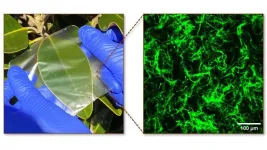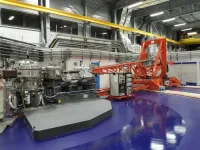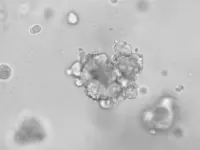(Press-News.org) Materials with enhanced structure derived from crustaceans and seaweed could be part of a next-generation answer to the challenge of replacing petroleum-based plastic films, according to new research from North Carolina State University.
Combining chitosan, a biopolymer that makes crab shells hard, with agarose, a biopolymer extracted from seaweed that is used to make gels, creates unique biopolymer composite films with enhanced strength. The films are also biodegradable, have antibacterial properties, repel water and are transparent. The findings could eventually lead to sustainable packaging films for food and consumer goods.
“How do we find sustainable replacements for synthetic polymers?” asked Orlin Velev, S. Frank and Doris Culberson Distinguished Professor of Chemical and Biomolecular Engineering at NC State and corresponding author of a paper describing the research. “Synthetic polymers make very good films, but we want to replace them with natural biopolymers. The question becomes how do we adjust the joint structure of these natural polymers – in our case, agarose and chitosan – so we can have all the desirable properties of synthetic polymers inside a sustainable, biodegradable film?”
It may not be enough to simply mix chitosan and agarose together. Velev says previous efforts to produce such mixtures reported improvements in properties, but when dried created gritty films that may lack the right strength.
Instead, Velev and his collaborators took a different approach, reinforcing the agarose films with fibrillated colloidal scale material – called soft dendritic colloids – made from chitosan. The strong chitosan micro- and nanoscale fibrils are hierarchically branched to provide strength and stability to the agarose film where they are embedded.
“It is challenging to modify natural polymers chemically, but we can alter their morphology and use them as composites,” said Yosra Kotb, an NC State Ph.D. graduate and first author of the paper. “We use chitosan dendritic particles to reinforce the agarose matrix because of the compatibility of both materials leading to good mechanical properties; chitosan particles also have an opposite charge to agarose. When mixed, these charges are neutralized so the resulting materials also become more resistant to water.”
The biopolymer composites are about four times stronger than agarose films alone, the research shows, and also resist E.coli, a commonly studied bacterium. The paper also showed that a sheet made from biopolymer composite films greatly degraded after a month underground, while, for comparison, a common plastic sandwich baggie remained completely intact after the same period underground.
“Interestingly, our composite is initially strongly antibacterial,” Velev said, “but because it is made from natural materials, after some time bacteria will still colonize it – so after a month underground it will biodegrade readily.”
Velev added that his lab will continue working to make improvements in the structure of the biopolymer composite films with the goal of eventually matching the properties of synthetic polymer ones.
“If you package food, you want the package to be impermeable to oxygen and water,” he said. “But natural materials are permeable, so we will continue to work to make our films more impermeable to water and oxygen.”
Increasing the scalability of the material production process is also one of the future goals. “How do you make the polymer substitute film in a continuous process that is rapid enough to make it in large enough amounts – like papermaking?” Velev said.
The findings appear in Cell Reports Physical Science. NC State has filed a patent application on the new biopolymer composite films and the process for creating them. The research has been supported by the National Science Foundation under grant CMMI-2233399, and partially by EFMA-2029327, CMMI-1825476 and CMMI-2134664.
- kulikowski -
Note to editors: The abstract of the paper follows.
“Hierarchically reinforced biopolymer composite films as multi-functional plastics substitute”
Authors: Yosra Kotb and Orlin D. Velev, North Carolina State University
Published: Dec. 11, 2023, in Cell Reports Physical Science
DOI: 10.1016/j.xcrp.2023.101732
Abstract: The replacement of synthetic plastics with biodegradable alternatives made from abundant and sustainable raw materials is a challenge of high societal importance. We report a class of high-performance multifunctional composite films made of nano- and microscale reinforced naturally sourced biopolymers. These films are made of an agarose matrix reinforced with hierarchically branched soft dendritic colloids (SDCs) from chitosan. Owing to the highly entangled hierarchical network of the SDC nanofibrils, the reinforced composite has excellent performance with more than 4× higher toughness than non-reinforced agarose, high visible light transmittance, improved hydrostability, and remarkable bactericidal activity. Thus, these reinforced biopolymer composites could match or exceed the excellent mechanical, barrier, and optical properties of common synthetic polymer films. We also demonstrate the soil biodegradability of this composite material in a controlled environment. The results suggest a universal strategy for manufacturing natural-source composite materials that could serve as substitutes for petroleum-based plastics.
END
MIT researchers have used 3D printing to produce self-heating microfluidic devices, demonstrating a technique which could someday be used to rapidly create cheap, yet accurate, tools to detect a host of diseases.
Microfluidics, miniaturized machines that manipulate fluids and facilitate chemical reactions, can be used to detect disease in tiny samples of blood or fluids. At-home test kits for Covid-19, for example, incorporate a simple type of microfluidic.
But many microfluidic applications require chemical reactions that must be performed at specific temperatures. These more complex microfluidic devices, which are typically manufactured in a clean ...
Milan, December 11, 2023 - Taking a significant step forward in superconductivity research, the discovery could pave the way for sustainable technologies and contribute to a more environmentally friendly future.
The study just published in Nature Communications by researchers from Politecnico di Milano, Chalmers University of Technology in Göteborg and Sapienza University of Rome sheds light on one of the many mysteries of high-critical-temperature copper-based superconductors: even at temperatures above the critical temperature, they are special, behaving like "strange" metals. This means that their electrical resistance ...
ARLINGTON, VA and DALLAS, December 11, 2023 — The American Diabetes Association® and the American Heart Association® have awarded grants to 10 community organizations to help people living with Type 2 diabetes lower their risk for cardiovascular diseases like heart attack, heart failure and stroke.
The community grants are part of the leading health non-profits’ joint Know Diabetes by Heart™ initiative which seeks to reduce cardiovascular events and deaths among people living with Type 2 diabetes. The grants will help organizations in California, Florida, Georgia, ...
A Stanford Medicine-led, international study of hundreds of samples from patients with Hodgkin lymphoma has shown that levels of tumor DNA circulating in their blood can identify who is responding well to treatment and others who are likely to experience a disease recurrence — potentially letting some patients who are predicted to have favorable outcomes forgo lengthy treatment.
Surprisingly, the study also revealed that Hodgkin lymphoma, a cancer of the lymph nodes, can be divided into two groups, each with distinct genetic changes and slightly different prognoses. These changes hint ...
The current emoji library doesn’t accurately represent the “tree of life” and the breadth of biodiversity seen in nature according to an analysis presented December 11 in the journal iScience. A team of conservation biologists categorized emojis related to nature and animals and mapped them onto the phylogenetic tree of life. They found that animals are well represented by the current emoji catalog, whereas plants, fungi, and microorganisms are poorly represented. Within the animal kingdom, vertebrates were overrepresented while arthropods were underrepresented with respect to their actual biodiversity. The researchers argue that creating a more diverse and representative ...
About The Study: High body mass index (BMI) in late adolescence was associated with early chronic kidney disease in young adulthood in this study that included 593,000 adolescents. The risk was also present in seemingly healthy individuals with high-normal BMI and before 30 years of age, and a greater risk was seen among those with severe obesity. These findings underscore the importance of mitigating adolescent obesity rates and managing risk factors for kidney disease in adolescents with high BMI.
Authors: Gilad Twig, M.D., Ph.D., of the Israel Defense Forces, Medical Corps, Tel Hashomer, Ramat Gan, Israel, is the corresponding author.
To ...
Embargoed for release: Monday, December 11, 11:00 AM ET
Key points:
In a study of 3.5 million pregnancies across four countries between 2009 and 2021, researchers observed no elevated risk of major congenital malformations, including major cardiac malformations, among infants born to pregnant women with pre-gestational type 2 diabetes who took second-line non-insulin antidiabetic medications compared with those who took insulin.
The researchers observed an increase in use of second-line non-insulin antidiabetic ...
The Organoid Group (Hubrecht Institute) and the Rare Cancers Genomics Team (IARC/WHO) found a way to grow samples of different types of neuroendocrine tumors (NETs) in the lab. While generating their new model, the researchers discovered that some pulmonary NETs need the protein EGF to be able to grow. These types of tumors may therefore be treatable using inhibitors of the EGF receptor. The results were published in Cancer Cell on 11 December 2023.
Neuroendocrine tumors
Neuroendocrine tumors (NETs) are relatively ...
BOSTON – Physician-investigators at Beth Israel Deaconess Medical Center (BIDMC) compared a chatbot’s probabilistic reasoning to that of human clinicians. The findings, published in JAMA Network Open, suggest that artificial intelligence could serve as useful clinical decision support tools for physicians.
“Humans struggle with probabilistic reasoning, the practice of making decisions based on calculating odds,” said the study’s corresponding author Adam Rodman, MD, an internal medicine physician and investigator in ...
People who have been subject to abuse are more likely to experience physical and mental health effects than previously thought, according to a new study.
In a global review and meta-analysis of evidence published in Nature Medicine today, researchers have found that there are elevated risks between intimate partner violence or childhood sexual abuse, and some health conditions including major depressive disorder, maternal miscarriage for partners, and alcohol misuse and self-harm among children.
Globally, one in three ever-partnered women have experienced ...





